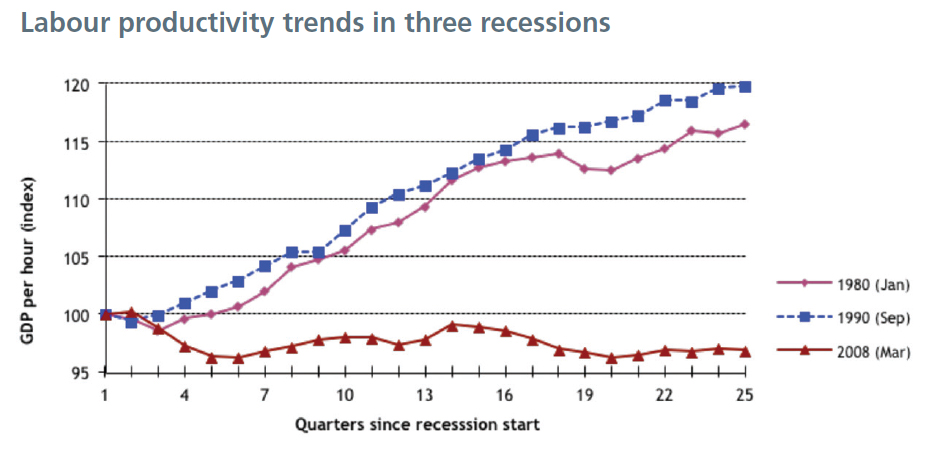IES Viewpoint: Productivity puzzles and poor performance
1 Sep 2014
Nigel Meager, Director
 The good news is that the ONS recently (September 2014) revised the official GDP data, and it turns out that the post-2008 economic downturn was not as deep as previously thought. The bad news is that it was still deeper than any since the 1930s, and the recovery since 2010 has been snail-like. It took six years for GDP to (just) get back to its pre-recession level; after the 1980s and 1990s recessions, it took only 3-4 years.
The good news is that the ONS recently (September 2014) revised the official GDP data, and it turns out that the post-2008 economic downturn was not as deep as previously thought. The bad news is that it was still deeper than any since the 1930s, and the recovery since 2010 has been snail-like. It took six years for GDP to (just) get back to its pre-recession level; after the 1980s and 1990s recessions, it took only 3-4 years.
As we’ve discussed here several times, the UK’s employment performance has been remarkably good despite this dire economic record. Total employment held up much better than in the last two recessions and recovered much faster. This has been attributed to various factors, including the UK’s much lauded ‘flexible labour market’, manifested by a growth in short-term, part-time jobs and self-employment, alongside a significant fall in real wages. More effective government welfare-to-work policies may also have helped.
Commentators have now started to notice the inevitable concomitant of these two key features (weak GDP and ‘strong’ employment), namely the unusual trend in labour productivity. After previous recessions (see graph) productivity grew fast, initially a ‘batting average’ effect as the least productive firms went to the wall, and surviving firms shed less-productive labour. As GDP started to pick up, productivity growth continued, as firms are cautious about hiring when orders grow, taking the opportunity to review working practices and invest in new machinery. New (more productive) businesses come into the market as growth continues. This is the “creative destruction” of the capitalist business cycle. This time, we’ve seen nothing like that, rather productivity (output per hour) has been falling or stagnant since 2008. It’s still not back to its underlying growth path, and the ‘productivity gap’ between the UK and its competitors has widened alarmingly.

Does it matter? Well yes, especially since it’s gone on for so long, and productivity is still stagnating despite the resumption of economic growth. Economists, policy-makers and the Bank of England[1] have started to worry about a semi-permanent loss of competitiveness, and there has been a rash of suggestions about the cause of the “productivity puzzle”. Currently, the best guess is that it reflects several factors coming together at the same time.
One relates to wages. It’s very unusual that real wages should be squeezed for such an extended period. While it initially helped firms retain staff in the early stages of the downturn, it has clearly gone on for far too long. Apart from the negative effects on household incomes, continued “cheap” labour provides an incentive for firms to engage or remain in labour-intensive activities rather than invest in capital, innovation and new technology.
Capital investment itself has indeed been at low levels for several years, not least because the financial system has been poor at directing finance to business investment. Despite the Bank of England’s efforts, too much capital has been shoring up post-crisis bank balances, or leaking into housing, rather than funding business investment, which would help reverse the productivity slump.
Some argue that a shift between sectors may have played a role, with growing shares of GDP in low-skilled service sectors, and jobs lost in capital-intensive high-productivity sectors (oil, pharmaceuticals etc.). This can’t be the whole story, though, because productivity has also been falling within individual sectors. Which leads to skills – are we now reaping the longer-term effects of the UK’s underinvestment in middle level, especially technical, skills? Arguably too many new kinds of business thriving post-recession are low valueadded businesses with low skill requirements (matching the historically weak skills profile of the UK workforce), while firms with higher skill requirements are starting to struggle (anecdotally, reports of skills shortages are increasing[2]).
Finally, we should mention the composition of recent employment growth, and the surprising expansion of self-employment. While much of this is due to the existing self-employed staying in work[3] (in some cases because they can’t afford to retire), some of it is new entrants. It’s unclear how far the latter are dynamic entrepreneurs creating new businesses of the future, and how far they’re an army of ‘odd-jobbers’ hanging on to a foothold in the labour market through bits and pieces of freelance work[4] (or even very little work at all, but calling themselves self-employed to be able to claim tax credits). Certainly there’s some evidence of a recent shift in the occupational and sectoral profile of the self-employed, alongside massive growth in part-time self-employment, and a big fall in their real earnings. All this gives support to the odd-job hypothesis, and the idea that much recent jobs growth has been among freelancers not contributing much to GDP, but helping to drag down the overall productivity figures.
So the productivity puzzle is, it seems, a jigsaw, with many interlocking pieces. What’s clear, however, is that the longer the divergence from trend productivity growth continues, the harder it will be to catch up with our international competitors. Ultimately this implies lower average per capita income, with major political and social implications in the years ahead.
Footnotes
[1] http://www.bankofengland.co.uk/publications/Documents/quarterlybulletin/2014/qb14q201.pdf
[2] UK Commission for Employment and Skills (2014), The future of work: jobs and skills in 2030.

